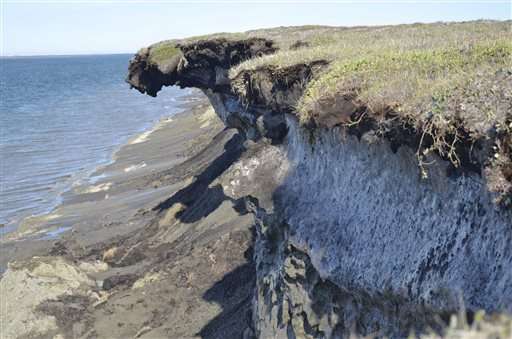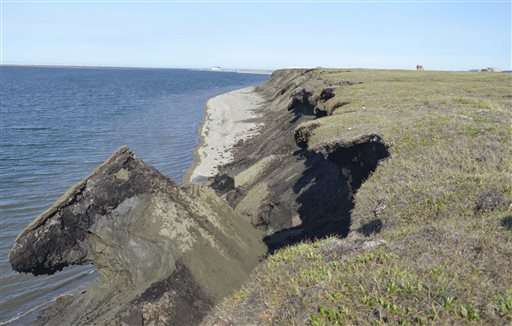New USGS report: Coastal erosion threatens northern Alaska

Erosion is eating away at Alaska's northern coast at some of the highest rates in the nation, threatening habitat and infrastructure, according to a new report published Wednesday.
The U.S. Geological Survey study looked at more than 50 years of data and found an average yearly shoreline change of 1.4 meters—or more than 4 1/2 feet—taking both beach erosion and expansion into account. Extreme cases showed an annual difference of more than 60 feet (18.3 meters).
"Probably the take-home message is that the north coast of Alaska is predominantly erosional—84 percent of the coast is eroding," USGS geologist Ann Gibbs said Wednesday.
The report provides baseline information for an area studied far less than other parts of the country, Gibbs said. The new study looked at nearly 995 miles of the coast between Alaska's icy Cape and the Canada border.
The study is part of an ongoing assessment of the nation's shoreline. None of the studies address climate change.
Gibbs, the lead author in the study, said there is no national erosion average from the previous studies, but most places showed shoreline changes of less than 1 meter per year, and a bit higher in Gulf states like Mississippi and Louisiana. Extreme shoreline changes in Louisiana were as high as 22 feet (6.7 meters) per year, she said.
Still to be studied in the national project are Alaska's western and southern coast, as well as the Great Lakes area on the mainland.

The erosion in northern Alaska tends to occur only in the few warmer months in the summers, Gibbs said.
Walt Audi has witnessed much of the shoreline changes himself as a 51-year resident of the far north village of Kaktovik, which lies within the Arctic National Wildlife Refuge about 640 miles (1,030 kilometers) north of Anchorage. As far as he's concerned, climate change is to blame.
These days, Audi said, at the height of summer he can look out at the ocean and there's no ice as far as he can see.
The 76-year-old owner of a local hotel, Audi remembers the old days when supply barges sometimes couldn't come in to deliver goods because of thick summer shore ice. That served an important purpose in protecting the coastline, he said.
"That kept the waves from crashing in as bad as they are now," he said.
More information: is.gd/1cJsjV
© 2015 The Associated Press. All rights reserved.














